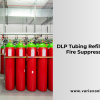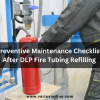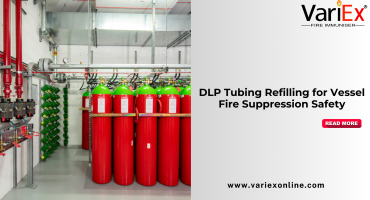![]()
Fire Immuniser
+91-7829629111
Email: info@variex.in
Varistor Technologies Pvt. Ltd.
Block-1, First Floor, Ardente Office One, Hoodi Circle, ITPL Main Road, Bengaluru, Karnataka 560048, IN
Co2 Fixed Fire Fighting System
CO2 fixed fire fighting systems are vital components of fire protection strategies in various industries and facilities. These systems utilize carbon dioxide (CO2) to suppress fires quickly and effectively, making them suitable for use in environments where water-based suppression methods may be impractical or hazardous. In this article, we'll delve into the details of CO2 fixed fire fighting systems, including their components, operation, benefits, and considerations for implementation.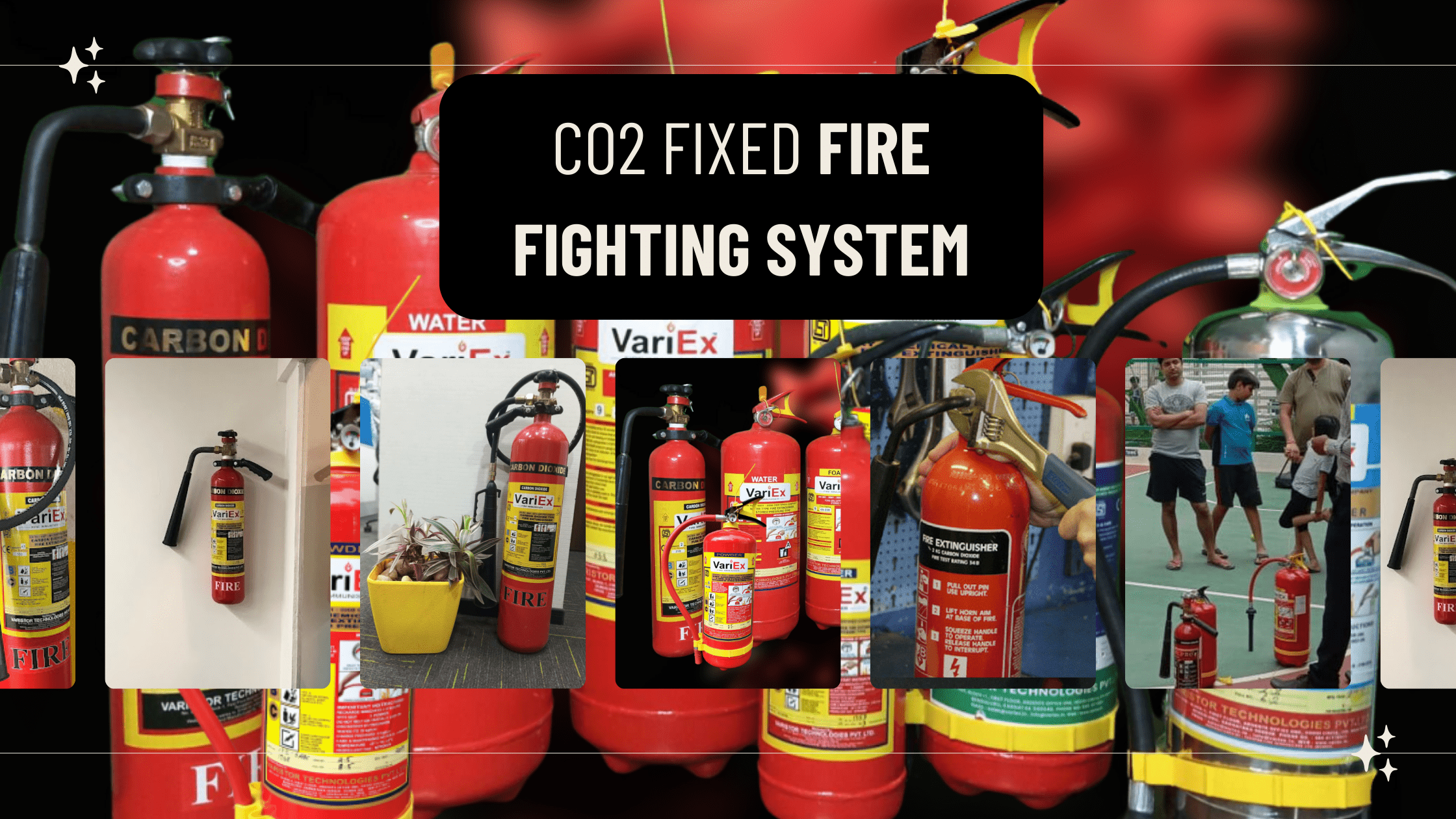
1. Components of CO2 Fixed Fire Fighting Systems:
- CO2 Storage Tanks: CO2 is stored in high-pressure cylinders or bulk storage tanks located within the system. These tanks are designed to contain and release the CO2 when activated.
- Release Mechanisms: Release mechanisms, such as electric or pneumatic valves, are used to discharge the CO2 into the protected area when the system is activated.
- Distribution Piping: Distribution piping routes the CO2 from the storage tanks to the protected areas, ensuring even coverage for effective fire suppression.
- Nozzles or Discharge Outlets: Nozzles or discharge outlets are strategically positioned throughout the protected area to distribute the CO2 and suppress fires.
2. Operation of CO2 Fixed Fire Fighting Systems:
- When a fire is detected, the CO2 fixed fire fighting system is activated either manually or automatically through fire detection devices.
- The release mechanism opens, allowing the pressurized CO2 to flow through the distribution piping and discharge outlets into the protected area.
- The CO2 displaces oxygen in the air, suffocating the fire by reducing the oxygen concentration below the level necessary for combustion.
- CO2 fixed fire fighting systems are typically designed to suppress fires quickly, minimizing damage and preventing the spread of flames.
3. Benefits of CO2 Fixed Fire Fighting Systems:
- Fast and Effective Suppression: CO2 fixed fire fighting systems can suppress fires rapidly, reducing the risk of extensive damage and protecting valuable assets.
- Non-Conductive and Residue-Free: CO2 is non-conductive and leaves no residue, making it suitable for protecting electrical equipment and sensitive materials.
- Versatile Applications: CO2 fixed fire fighting systems are suitable for a wide range of applications, including industrial facilities, data centers, electrical substations, and flammable liquid storage areas.
- Minimal Cleanup: Unlike water-based suppression methods, CO2 fixed fire fighting systems require minimal cleanup after activation, allowing for swift recovery and resumption of operations.
4. Considerations for Implementation:
- Safety Considerations: CO2 fixed fire fighting systems can displace oxygen and present a risk of asphyxiation if not properly controlled. Adequate ventilation and safety measures must be in place to protect personnel.
- Regulatory Compliance: Compliance with local fire codes, industry standards, and regulatory requirements is essential when designing, installing, and operating CO2 fixed fire fighting systems.
- Regular Maintenance: Routine inspection, testing, and maintenance of CO2 fixed fire fighting systems are necessary to ensure proper functionality and reliability in the event of a fire emergency.
Conclusion
CO2 fixed fire fighting systems are valuable assets in fire protection strategies, offering fast and effective suppression capabilities for a wide range of applications. Understanding the components, operation, benefits, and considerations for implementation of these systems is essential for ensuring the safety and protection of personnel, property, and critical assets in the event of a fire emergency. Working with qualified professionals and adhering to industry best practices and regulatory requirements can help maximize the effectiveness and reliability of CO2 fixed fire fighting systems.
FREQUENTLY ASKED QUESTIONS
A CO2 fixed fire fighting system is a fire suppression system that utilizes carbon dioxide (CO2) as the extinguishing agent. It is designed to quickly and effectively suppress fires in various environments, including industrial facilities, data centers, and electrical substations.
When activated, a CO2 fixed fire fighting system releases pressurized CO2 from storage tanks through distribution piping and discharge outlets into the protected area. The CO2 displaces oxygen, suffocating the fire by reducing the oxygen concentration below the level necessary for combustion.
CO2 fixed fire fighting systems are commonly used in environments where water-based suppression methods may be impractical or hazardous, such as areas containing electrical equipment, flammable liquids, or sensitive materials. They are often found in industrial facilities, electrical substations, data centers, and marine applications.
While CO2 is an effective fire extinguishing agent, it can displace oxygen and present a risk of asphyxiation if not properly controlled. Adequate ventilation and safety measures must be in place to protect personnel during system activation.
Some benefits of CO2 fixed fire fighting systems include fast and effective suppression of fires, non-conductive and residue-free extinguishing agent, versatility for various applications, and minimal cleanup after activation.
Yes, compliance with local fire codes, industry standards, and regulatory requirements is essential when designing, installing, and operating CO2 fixed fire fighting systems. These requirements may vary depending on the jurisdiction and the specific application of the system.
Routine inspection, testing, and maintenance of CO2 fixed fire fighting systems are necessary to ensure proper functionality and reliability in the event of a fire emergency. The frequency of inspections and maintenance may vary depending on regulatory requirements and manufacturer recommendations.
Final Say
We at VariEx.in or Variexonline.com have mastered the art of designing, installing, inspecting, and fixing automatic sprinkler systems with the help of our in-house team, which is capable of delivering the fire sprinkler services you need, whether large or small and at affordable cost.
To schedule a fire sprinkler installation, or you think our services could benefit your commercial property, contact us online or give us a call at, 7829629111
"WHAT YOU CAN READ NEXT"
 Read more +24 November 2023 in Fire Extinguisher
Read more +24 November 2023 in Fire ExtinguisherWhat types of fire extinguishers are available for different fire classes?
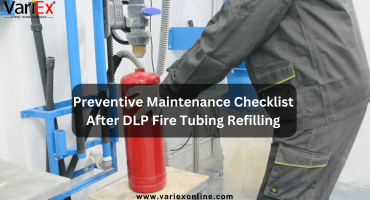 Read more +11 July 2025 in Fire Suppression
Read more +11 July 2025 in Fire Suppression

